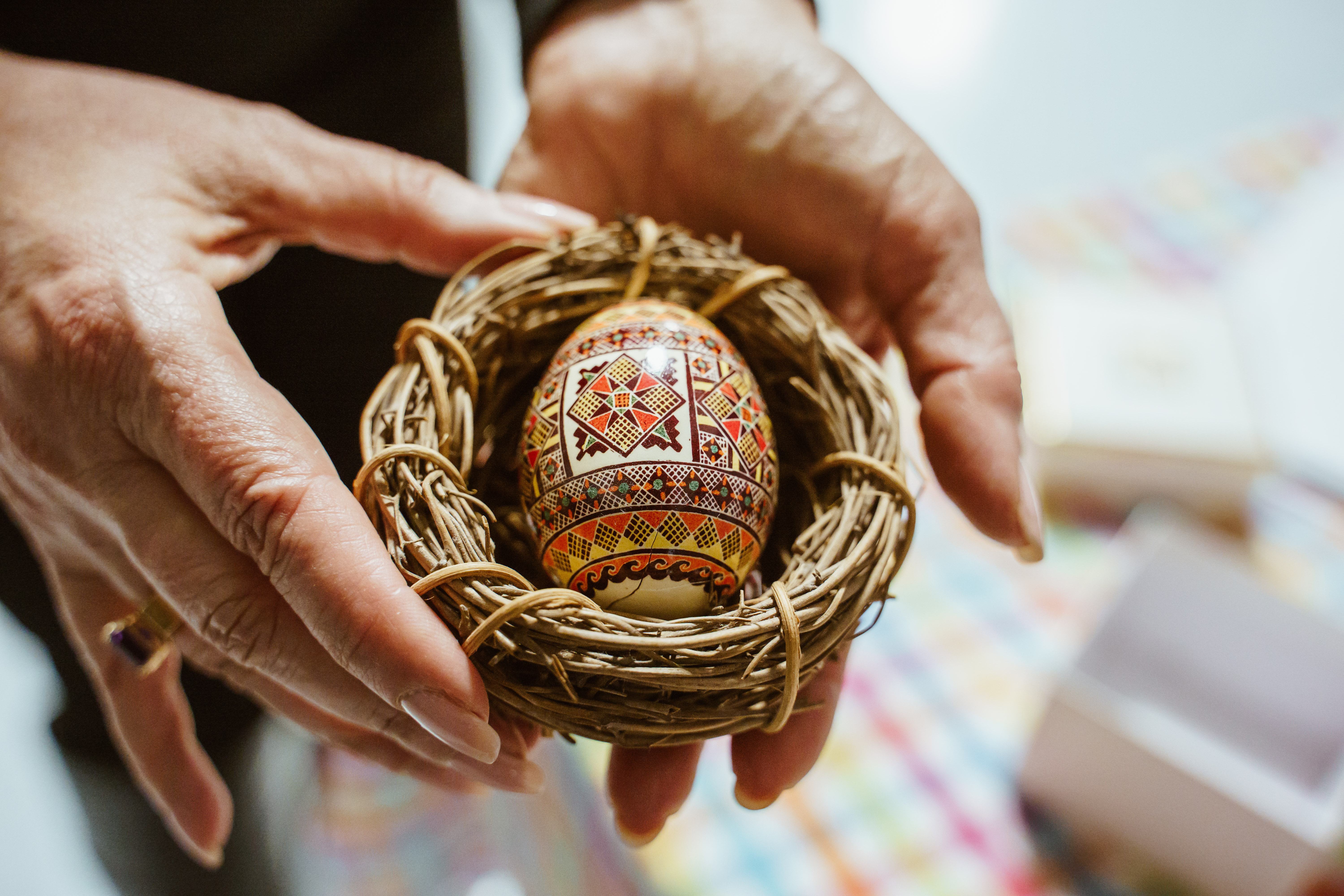Ancient pysanka designs keep ancestral culture alive for Ukrainian Catholics living in Metro Detroit
WARREN — Bright colors and wicker baskets are synonymous with Easter in many cultures, but as churches around Metro Detroit celebrate the holy season, the elaborate and decorative Ukrainian traditions stand out among the rest.
Famously know as the pysanka, the Ukrainian-style Easter egg is a staple this time of year. The colorful and intricately designed eggs are described as “written,” not “painted,” in a wax-resist method of traditional folk patterns.
For Eugenia Korovaychuk, a seventh-grader at Immaculate Conception Ukrainian Catholic School in Warren, spending time preparing for Easter making pysanka with her family is not only part of her tradition, it also ties her closely to the life she remembers in Ukraine. She left her home country when she was just 7 years old.
“In a way, (writing the eggs) makes me special and unique and different than everyone else,” Eugenia told Detroit Catholic. “It’s a really unique tradition, and our ancestors have been doing this before us.”

She added the eggs are a sign of happiness and growth.
“Eggs symbolize life for Easter, and Jesus’ resurrection symbolizes new life,” she said.
Fr. Daniel Schaicoski, pastor of Immaculate Conception Ukrainian Catholic Church in Hamtramck, said the pysanka can be traced back before Christianity, when pagan sun worshipers painted eggs because the yolk reminded them of the sun.
At the advent of Christianity, the tradition began to take on a new meaning.
“Once Christianity came to Ukraine, it was explained that the sun was the symbol of light and God, and then the pysanka’s symbolism became greater,” Fr. Schaicoski said. “Pysanka fit perfectly into the Christian faith to represent the Resurrection.”
Fr. Schaicoski, who was raised in Brazil, said the pysanka was also an important symbol for Ukrainians living in various parts of the world and for those who lived in Ukraine when it was ruled by the Soviet Union.

“The decorated egg kept Ukraine alive for us during the reign of the Soviet Union,” Fr. Schaicoski said.
Ukrainian Catholics are devout in their Easter traditions, which include fasting three weekdays during Lent.
In turn, the preparation of Easter baskets includes meat and pork, which become the celebratory foods for Easter morning.
Per tradition, the baskets are filled with an elaborate pysanka, paska (Easter bread), horseradish, bacon, cheese, salt, sausage, ham and kielbasa, must be blessed on Holy Saturday as the items for the first meal consumed after the end of Lent.
“You’re celebrating the Resurrection and enjoying all the food,” Fr. Schaicoski said of the Easter morning meal.
Immaculate Conception eighth-grader Chrystyna Zavadenko said writing pysanka is her favorite Easter tradition. The process of using beeswax to cover the important colors is key to a perfect end result, though it is not revealed until the entire design is complete and the wax melted, she said. The designs are typically symmetrical and often have a lace effect.


“This technique is really old, and even though Ukraine was not the only place it was done, there are special Ukrainian symbols and we do them to preserve this culture,” Chrystyna said.
“It's very symbolic of Ukraine,” added Dr. Luba Petrusha, a medical doctor who has been a passionate advocate in the writing of pysanka and has her own website dedicated to the history and details of the ancient tradition. “It's something you find in every part of Ukraine.”
She said the use of painted eggs was symbolic during Lent, when the eggs were not eaten. Those eggs were saved and the nicest white ones were used to be dyed. Friends would exchange eggs with one another, typically using intricate embroidery patterns.
“Ukrainians love pretty things,” she added.
She said the use of pysanka has come back into Ukrainian culture again since the country gained its independence.
Each year, Dr. Petrusha holds workshops in conjunction with Wayne State University’s Slavic department to teach students interested in the art.

To begin, the raw eggs, which have no signs of cracks, are cleaned with mild dish soap. She explained eggs must be a room temperature; keeping the egg out overnight is best.
“Cooking the eggs damages the shell, making it difficult for the dye to stick,” Dr. Petrusha said. Some people empty the egg of its content by poking a pinhole in the bottom that is later plugged, but Dr. Petrusha doesn't recommend that.
“The eggs will float in the dye instead of sinking and must be weighed down,” she explained.
The dyes, too, must also be prepared at room temperature. Typically, the dyes used are made for dying fibers like wool or silk.
To write the eggs with the dye, a stylus, known as a pysachok, is made with a wooden dowel.

“Traditionally, a piece of thin brass was wrapped around a needle, forming a hollow cone,” Dr. Petrusha explained. The cone scoops up pure beeswax that is heated over a candle and then applied on the egg to preserve the color underneath.
“Paraffin and many other waxes have melting points lower than that of beeswax, and will smear or not adhere to the egg properly,” she said.
Dr. Petrusha said beeswax turns black when heated, making it easy to see the design once it has been applied. Petrusha, who is passionate about the designs, uses professional electric tools to keep her wax to be evenly applied.









